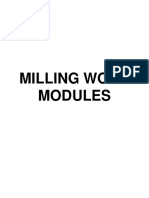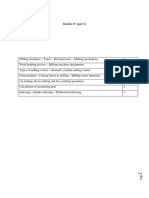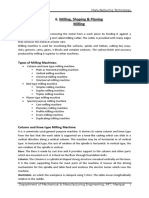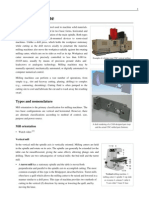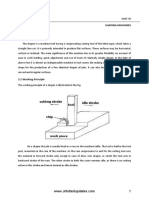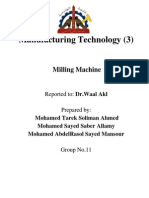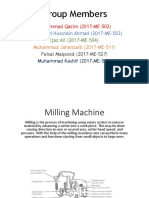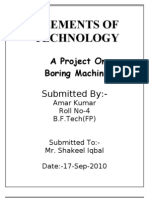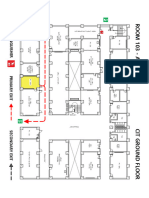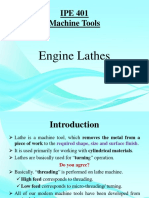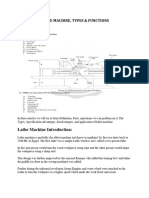Milling Machine
Milling Machine
Uploaded by
Anand BalajiCopyright:
Milling Machine
Milling Machine
Uploaded by
Anand BalajiOriginal Description:
Copyright
Share this document
Did you find this document useful?
Is this content inappropriate?
Copyright:
Milling Machine
Milling Machine
Uploaded by
Anand BalajiCopyright:
INRODUCTION
MILLING MACHINE
THEORY
Milling machine
Introduction :A milling machine is a machine tool that removes metal as the
work is fed against multi-point culler. The machine can hold
more than one cutter at a time. It is superior to other
machines as regards to accuracy and surface finish.
Principal parts:
a) Base: It is a grey c.i casting serves as a foundation for all
other parts. In some machines base is hallow serves as
reservoir for cutting fluid.
b) Column: It is main supporting frame mounted vertically
on base. The column is box shaped heavily ribbed and
houses all driving mechanism for spindle and table feed.
c) Knee: The knee is a rigid grey cast iron casting that slides
up and down on vertical ways of column face. The knee
houses feed mechanism of table to provide guide ways
for table.
d) Table: It rests on ways of saddle and travels
longitudinally. The table may be swiveled horizontally.
e) Spindle: The spindle of machine is located on upper part
of column and delivers power from motor through bells,
motor, and clutcher and transmits it to arbor.
f) Arbor: It may be considered as extension or m/c spindle
on which milling cutter are securely mounted and
rotated.
Machining centre :1
INRODUCTION
MILLING MACHINE
THEORY
A machine centre is characterized by
(i) Indexable tool magazine :- The tool magazine may carry
16 to 100 tools depending upon its capacity. An
automated tool changer (ATC) is provided to pick up the
programmed tool from tool magazine and mount it on the
spindle. The removed tool is put back into magazine and
mounts it on the spindle.
(ii) Pallets :- They are often provided with two or more work
tables called pallets. In a 2 pallet machine while the job on
one pallet is being machined, the operator can set up the
next job on the free pallet. The automatic pallet changer
then moves the pallet.
Column and
Knee type
Milling
machine
Planar
type
Manufacturing
or fixed bed
type
Special
type
Hand milling
machine
Plain milling
machine
Universal milling
machine
Vertical milling
machine
Simplex milling
machine
Duplex milling
machine
Triplex milling
machine
Rotary table
milling machine
Drum milling
machine
INRODUCTION
MILLING MACHINE
THEORY
Hand milling machine : Feeding movement of the table is supplied by hand
control.
They are used for light and simple milling operations such
as machining slots, grooves and key-ways.
Plain milling machine :
They are much more rigid and sturdy than hand millers
for accommodating heavy work pieces.
The milling machine table may be fed by hand or power
against a rotating cutter mounted on a horizontal arbor.
The table may be fed in a longitudinal cross or vertical
directions.
Universal milling machine :
This is so named because it may be adapted to a very
wide range of milling operations.
In this machine has a fourth movement of table in
addition to above three.
The table can be swiveled horizontally and can be fed to
an angle to milling machine spindle. The table can be
INRODUCTION
MILLING MACHINE
THEORY
swiveled about a vertical axis and set at an angle other
than right angle to spindle.
It is provided with auxiliaries such as dividing head
attachment and rotary table etc.
The special design of machine itself to make spur, bevel
gears, reamers, milling cutters and other tool room work
operations.
Vertical milling machine :
It is distinguished from a horizontal milling machine by
the position of its spindle which is vertical or
perpendicular to work table.
The machine may be of plain or universal type and has all
movement of table for proper setting and feeding the
work.
The spindle head which is clamped to vertical column
may be swiveled at an angle, permitting the milling cutter
mounted on the spindle to work on angular surfaces.
INRODUCTION
MILLING MACHINE
THEORY
Manufacturing or fix bed type machine :
They are large, heavy and rigid differ radically from
column and knee type milling machine.
The table is mounted directly on the ways of fixed bed.
The table movement is restricted to reciprocation at right
angles to spindle axis with no provision for cross or
vertical adjustment.
The cutter mounted on the spindle head may be moved
vertically on the column and the spindle may be adjusted
horizontally to provide cross adjustment.
In duplex machines, spindle heads are arranged one on
each side of table.
Plano miller type :
It is a massive machine built up for heavy duty work,
having spindle heads adjustable in vertical and in
traverse directions.
Its resembles a planer and like a planning machine it has
a cross rail capable of being raised or lowered carrying
the cutters, all supported b rigid uprights.
This arrangement of independently driving multiple
cutter spindles enables number of work surfaces to be
machined simultaneously thereby obtaining great
reduction in production time.
There may be a number of independent spindles carrying
cutters on the rail as well as two heads on upright.
Special type milling machine :
INRODUCTION
MILLING MACHINE
THEORY
The construction of the machine is a modification of a
vertical milling machine and is adapted for machining flat
surfaces at production rate.
The fall milling cutters are mounted on two or more
vertical spindles and a number of work pieces are
clamped on horizontal surface of a circular table which
rotates about a vertical axis.
The cutters may be set at different heights relative to the
work so that when one of the cutters is roughing the
pieces, the other is finishing them.
Drum milling machine :
It is similar to a rotary table milling machine in that its
work supporting table which is called a drum, rotates in a
horizontal axis.
The face milling cutters mounted on 3 or 4 spindle heads
rotate in a horizontal axis and remove metal from work
pieces supported on faces of drum.
You might also like
- Milling Machine PDFDocument64 pagesMilling Machine PDFJhon Ashley Nahibuan50% (2)
- Emco Maximat V13 Lathe Manual: Read/DownloadDocument2 pagesEmco Maximat V13 Lathe Manual: Read/DownloadIbrahim Azhari0% (2)
- Ott-Jakob HSK-B Pe 2017-04Document33 pagesOtt-Jakob HSK-B Pe 2017-04VladimirAgeev100% (1)
- Unit III Milling Machine and Slotter 4SEM MP GCOE S N GANDHAREDocument20 pagesUnit III Milling Machine and Slotter 4SEM MP GCOE S N GANDHARE40 siddhesh petkarNo ratings yet
- MTDMDocument14 pagesMTDMsree_guruNo ratings yet
- Milling Machines2Document94 pagesMilling Machines2hari_1389100% (1)
- Prepared by S.sanyasirao, Assistant Professor, VITS College of Engg., Sontyam, VizagDocument14 pagesPrepared by S.sanyasirao, Assistant Professor, VITS College of Engg., Sontyam, Vizagsanyasirao1No ratings yet
- Milling MachinesDocument5 pagesMilling MachinesmaheshsangamreddiiasNo ratings yet
- MET307 M2 Ktunotes.inDocument50 pagesMET307 M2 Ktunotes.inbenjohnsphilippjNo ratings yet
- Milling Machines: Milli e Ains A Ause e H Ma - Why A - Up Rio e E, MD IsDocument10 pagesMilling Machines: Milli e Ains A Ause e H Ma - Why A - Up Rio e E, MD Isnitin gaikwadNo ratings yet
- MillingDocument47 pagesMillingAvinash KankipatiNo ratings yet
- 6 Notes Milling Shaping & PlaningDocument14 pages6 Notes Milling Shaping & PlaningSanket KumarNo ratings yet
- Milling MachiningDocument13 pagesMilling MachiningAshwin KumarNo ratings yet
- MillingDocument5 pagesMillingPsg GrtNo ratings yet
- Comparing Vertical With Horizontal: Machine Tool Machine Solid MaterialsDocument3 pagesComparing Vertical With Horizontal: Machine Tool Machine Solid MaterialsKarthikeya ReddyNo ratings yet
- MC-MT R16 - Unit-3Document63 pagesMC-MT R16 - Unit-3Anonymous GEHeEQlajbNo ratings yet
- Report 2 - MillingDocument34 pagesReport 2 - Millingمحمد طه100% (1)
- On Shaper Machine FinalDocument6 pagesOn Shaper Machine FinalSuraj Mukti100% (1)
- On Shaper Machine FinalDocument6 pagesOn Shaper Machine FinalPaida Vishweswar Rao0% (1)
- Shaper, Slotter and PlanerDocument9 pagesShaper, Slotter and PlanerRenjith RajendraprasadNo ratings yet
- Lecture 04_Milling MachinesDocument31 pagesLecture 04_Milling MachinesshezanlabibNo ratings yet
- 4-Boring MachineDocument36 pages4-Boring MachinekaushiksoniNo ratings yet
- Unit - Iv: Milling MachineDocument74 pagesUnit - Iv: Milling MachineDevarakonda KondayyaNo ratings yet
- Milling MachineDocument20 pagesMilling MachineTamil SelvanNo ratings yet
- Manufacturing Technology (3) : Milling MachineDocument33 pagesManufacturing Technology (3) : Milling MachinemohamedNo ratings yet
- Planing and Slotting OperationsDocument4 pagesPlaning and Slotting Operationsmanish kumarNo ratings yet
- Milling Mc3Document97 pagesMilling Mc3Hamisi MzariNo ratings yet
- Document from ρм.нтєєиαναиDocument28 pagesDocument from ρм.нтєєиαναиnavaneethmp9No ratings yet
- Milling NotesDocument20 pagesMilling NotesleoandresmessiNo ratings yet
- Milling Operation Group 6Document55 pagesMilling Operation Group 6Ann NavarroNo ratings yet
- Lecture 7 - Milling Machine Detailed LectureDocument45 pagesLecture 7 - Milling Machine Detailed LectureshahjahansiddikibipulNo ratings yet
- 003 MillingDocument59 pages003 MillingKalikene MwambeloNo ratings yet
- Tool Room Project ReportDocument49 pagesTool Room Project Reportlokeshkrkushwaha67% (3)
- Milling MachineDocument20 pagesMilling MachineMohd Radzi Kaki Limo100% (1)
- Milling Machine (Group 7)Document52 pagesMilling Machine (Group 7)Faisal Maqsood100% (1)
- Machine Shop: DefinitionDocument10 pagesMachine Shop: DefinitionAliNo ratings yet
- Shaping MachineDocument7 pagesShaping Machineuriy2000xyzNo ratings yet
- BME Milling and GrindingDocument16 pagesBME Milling and GrindingalysonmicheaalaNo ratings yet
- Planer MachineDocument7 pagesPlaner MachineFathy Gamal KhaledNo ratings yet
- Handout131Milling Machines and CuttersDocument23 pagesHandout131Milling Machines and CuttersPamela SidicNo ratings yet
- NR MillingDocument36 pagesNR MillingSapna VyasNo ratings yet
- Shaper Machine: TH THDocument20 pagesShaper Machine: TH THLokesh LokiNo ratings yet
- Milling: History of The Milling MachineDocument11 pagesMilling: History of The Milling MachineNikhil PrasannaNo ratings yet
- ch8 1Document1 pagech8 1Dumisani SitholeNo ratings yet
- Government Polytechnic, Sirsa: Branch: Mechanical Engineering Subject: Workshop Technology - Iii Semester: 5ThDocument168 pagesGovernment Polytechnic, Sirsa: Branch: Mechanical Engineering Subject: Workshop Technology - Iii Semester: 5ThJay YadavNo ratings yet
- Machining ProcessDocument54 pagesMachining ProcesskaushiksoniNo ratings yet
- Planer Machine:: DiagramDocument4 pagesPlaner Machine:: Diagramtanish vermaNo ratings yet
- Mamam601 Part IIDocument55 pagesMamam601 Part IIHirwa jean de DieuNo ratings yet
- Vertical Milling AttachmentDocument52 pagesVertical Milling Attachmentpramo_dassNo ratings yet
- Machine Tools - Milling MachineDocument11 pagesMachine Tools - Milling Machinejineesha p jNo ratings yet
- Module 3 ShaperDocument19 pagesModule 3 Shaperamanchauhan2603No ratings yet
- Shaper Planner SlotterDocument46 pagesShaper Planner SlotterRam Prasad YadavNo ratings yet
- Shaper and MillingDocument27 pagesShaper and MillingManish DharNo ratings yet
- MFT 2 Lab Manual-SasiDocument46 pagesMFT 2 Lab Manual-Sasisikkandar faizNo ratings yet
- Elements of Technology: A Project On Boring MachineDocument11 pagesElements of Technology: A Project On Boring MachineSandeep HarshvardhanNo ratings yet
- Boring MachineDocument24 pagesBoring MachineSandip Patel100% (2)
- KisarDocument15 pagesKisartgimranNo ratings yet
- MillingDocument46 pagesMillinghafizabrar309No ratings yet
- 3023 Machine Tools M3Document43 pages3023 Machine Tools M3arunsumesh.vfbvmNo ratings yet
- Reciprocating Type Machine ToolsDocument18 pagesReciprocating Type Machine ToolsSpartan 117No ratings yet
- How to Run a Lathe - Volume I (Edition 43) The Care and Operation of a Screw-Cutting LatheFrom EverandHow to Run a Lathe - Volume I (Edition 43) The Care and Operation of a Screw-Cutting LatheRating: 4.5 out of 5 stars4.5/5 (2)
- GrindingDocument6 pagesGrindingAnand BalajiNo ratings yet
- Drilling MachineDocument6 pagesDrilling MachineAnand BalajiNo ratings yet
- Lathe OperationsDocument7 pagesLathe OperationsAnand Balaji0% (1)
- Lathe AccessoriesDocument6 pagesLathe AccessoriesAnand Balaji100% (1)
- Lathe IntroductionDocument6 pagesLathe IntroductionAnand BalajiNo ratings yet
- Pp1 Module1 FundamentalsDocument15 pagesPp1 Module1 FundamentalsAnand BalajiNo ratings yet
- Friction T2 TestDocument5 pagesFriction T2 TestAnand BalajiNo ratings yet
- Drilling and Milling Machine WMD25VB From SYNTOP CNCDocument2 pagesDrilling and Milling Machine WMD25VB From SYNTOP CNCВладимир УсковNo ratings yet
- Turning Between CentersDocument29 pagesTurning Between CentersFeliciana Bitetti100% (1)
- S20x2 Deckel enDocument9 pagesS20x2 Deckel enalphatools100% (1)
- 5 - CNC Milling ProgrammingDocument40 pages5 - CNC Milling Programmingnguyen xuan HuyNo ratings yet
- Get Nursing Care Plans Guidelines for Individualizing Client Care Across the Life Span 10e free all chaptersDocument24 pagesGet Nursing Care Plans Guidelines for Individualizing Client Care Across the Life Span 10e free all chaptersrakeilermire100% (1)
- Bangalore Roadshow Confirmed ListDocument3 pagesBangalore Roadshow Confirmed ListpushkarhateNo ratings yet
- Room 103-ADocument1 pageRoom 103-ADavid ReyesNo ratings yet
- TornosDocument3 pagesTornosScarduelli100% (1)
- Main Catalog 500 04.2020 en Dok 0150d 0Document158 pagesMain Catalog 500 04.2020 en Dok 0150d 0yathiNo ratings yet
- IPE 401 Machine Tools: Engine LathesDocument44 pagesIPE 401 Machine Tools: Engine Lathesshourav2113100% (1)
- Dimension Free Tolerance Din 7168-gDocument1 pageDimension Free Tolerance Din 7168-gMohsen KianiNo ratings yet
- Non Destructive TestingDocument42 pagesNon Destructive TestingReplica DressesNo ratings yet
- Raj Kumar Sahoo Harsha 2Document2 pagesRaj Kumar Sahoo Harsha 2Prince SahaniNo ratings yet
- FME CNC Unit 5Document78 pagesFME CNC Unit 5B30parvej arif shahNo ratings yet
- Bison Manual Chucks 2022Document128 pagesBison Manual Chucks 2022perfectmachineserviceNo ratings yet
- Cu580M Universal LatheDocument5 pagesCu580M Universal LatheMinh PhamNo ratings yet
- LSP SMK Persatuan 2 Handel Pemutar: 3 Lathe CNC R3 R5 C1,5Document1 pageLSP SMK Persatuan 2 Handel Pemutar: 3 Lathe CNC R3 R5 C1,5M.samsul HudaNo ratings yet
- b12 b16 Citizen PCM Catalogue 11.2023Document7 pagesb12 b16 Citizen PCM Catalogue 11.2023Diego Martinez CNo ratings yet
- Fagor PC Simul - OptionsDocument1 pageFagor PC Simul - OptionsYoSoyCharlyeBobaryNo ratings yet
- UnimatDocument2 pagesUnimatAnonymous CD99NByNo ratings yet
- Colchester Alpha Brochure 2021Document7 pagesColchester Alpha Brochure 2021KhalilullahNo ratings yet
- Company ProfileDocument15 pagesCompany ProfileQualityNo ratings yet
- Shaper - WikipediaDocument15 pagesShaper - Wikipediabrianbett751No ratings yet
- Lathe MachineDocument13 pagesLathe Machinemboniface763No ratings yet
- Mill Keyways On LatheDocument1 pageMill Keyways On LatheJim100% (4)
- Heavy Machine Building Plant (HMBP) : WORKSHOP 010/011Document4 pagesHeavy Machine Building Plant (HMBP) : WORKSHOP 010/011Shahbaz AlamNo ratings yet
- MachDocument3 pagesMachGeoffrey CasanaNo ratings yet
- Section - 12 - Machine Tool Accessories - EbookDocument30 pagesSection - 12 - Machine Tool Accessories - Ebookandra100% (1)
